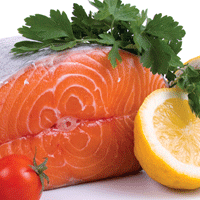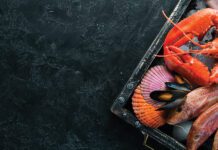The debate over sustainable seafood moves into a new era
As the old broken-heart placation suggests, there are plenty of fish in the sea. But, today, that’s not necessarily accurate, particularly if you’re after sturgeon caviar, Chilean sea-bass, or any number of endangered swimmers. For chefs searching for the smartest seafood to serve, there are no easy answers. But as the debate broadens — from a focus on single species, to discussions about specific salmon runs, fishing techniques and the social impacts of the fish we eat — we’re moving in a new direction and making rapid, eco-positive, changes.
In short, it’s gone way beyond the “farmed is bad, wild is good” debate. With nearly half of the seafood consumed globally raised on farms, aquaculture is a modern reality. But there are good and bad ways to farm, and catch, fish.
In Canada, oysters, mussels and clams are sustainably farmed on both coasts, as is Arctic char. But farming Atlantic salmon in open net cages is still a major environmental issue. And though it’s spawned clever new experiments, including a closed-containment Coho farm in B.C., there’s not nearly enough sustainable farmed salmon to feed the insatiable appetites of fish-fond diners.
Other fish farming is problematic, too. The world’s favourite seafood — large tropical shrimp — is now nearly all farmed in Southeast Asia and India, where it’s been an environmental and social disaster, destroying storm-buffering coastal mangroves, exploiting child labour and using largely unregulated amounts of antibiotics, pesticides and other chemicals.
Trap-caught B.C. spot prawns and Nova Scotia Ched-abucto Bay shrimp, Gulf shrimp and the small coldwater shrimp from Newfoundland’s northern waters, are sustainable alternatives, as are those farmed in closed containment systems in Texas; but again, demand far outstrips sustainable supplies.
The examples go on and on.
Confused? The waters may seem murky, but that’s because they’re at long last being churned. Groups like Canada’s Ocean Wise and Sea Choice, plus the international Marine Stewardship Council (MSC) have sensitized diners to the problems in our oceans, helping chefs and consumers wade through the latest science, to identify the most sustainable seafood products available.
“It is really confusing but we are still in the early days when it comes to sustainable fishing,” says Shauna MacKinnon of the Living Ocean Society, one of the members of Sea Choice, which publishes sustainable seafood guides for Canadian consumers, identifying red, yellow and green choices.
Ocean Wise, the Vancouver Aquarium’s eco-labelling initiative, has been a huge success, too, with its logo pointing consumers to sustainable choices on restaurant menus and at the seafood counter. After only five years, this West Coast initiative, which began with just 16 restaurants, has spread across Canada, with nearly 300 partners at more than 2,700 locations.
“The whole idea really caught on and grew faster than we expected,” says Ocean Wise program manager, Mike McDermid. “Now we’ve created a whole bunch of splinter groups, and we really do need a national standard to define sustainability.”
Since the program’s inception, sustainable seafood offerings on member menus have jumped from 47 per cent to 81 per cent and several restaurants now offer 100 per cent sustainable seafood menus. What’s more, many Ocean Wise members report sustainable menu items are their bestsellers. “Pacific sardines, trapped B.C. spot prawns, Albacore tuna, Arctic char — these are fish we didn’t see on menus three to five years ago,” says McDermid. “There’s been a real renaissance in a very short time.”
The two biggest hurdles for many Canadian chefs continue to be farmed salmon and shrimp. While there are new sustainable ways to produce both, demand for these still wildly outstrips supply. But, activists note, taking the unsustainable versions off the menu may be the best way to help sustainable production grow.
It’s already worked for other species. Ocean Wise stock may only be 20 per cent of some suppliers’ offerings, but makes up 50 per cent of their sales, notes McDermid. “It’s gone right down to the fisher and the farmer, with the incentive of getting value for their products by doing it right,” he adds.
David Garcelon, executive chef at Fairmont’s Royal York Hotel in Toronto, was one of the first Ontario chefs to sign on with the Ocean Wise program. In the hotel’s elegant Epic restaurant, the contemporary menu includes creative sustainable seafood dishes such as top-cured, bottom-seared Icy Waters char with smoked sunchoke purée ($26), B.C. halibut with Purdy Fisheries-farmed sturgeon caviar ($25) and guanciale-wrapped diver-scallops with lentils and Riesling froth ($27).
Garcelon is a major proponent of local, fresh and seasonal ingredients of all kinds, believing the hotel can make a big environmental and social impact with its purchasing choices. But it’s not always easy to run a major urban hotel and stay true to your ideals. For one thing, Garcelon can’t find a source of sustainable shrimp that meets customer and budgetary demands.
“We always have a sustainable catch of the day at Epic, and we’ve even been able to use sustainable B.C. halibut in our fish and chips in other hotel restaurants, but shrimp is still a problem,” says Garcelon, who also still uses Atlantic salmon from farms in New Brunswick’s Bay of Fundy.
Garcelon is following the lead of western Canadian chefs like Robert Clark of C restaurant in Vancouver. Clark, who helped launch the Ocean Wise program, is the poster boy for sustainable seafood — seeking out small fishers to supply his upscale restaurant and experimenting with plentiful, if less prestigious, fish like pink salmon.
Other Vancouver chefs have followed suit. Frank Pabst of Blue Water Café, made it his mission to introduce diners to the weird and wonderful side of sustainable seafood by developing his own annual ‘Unsung Heroes’ promotion featuring sea urchin, octopus and sardines.
“Sustainable seafood is not only about which fish you pull from the water but about how you catch them and what impact fishing has on the ocean and on other species,” writes Pabst in the introduction to his Blue Water Café: Seafood cookbook. “We promote wild seafood, first and foremost, but we only take fish from people who we know practice responsible methods.”
The chefs are making headway and, even though it’s not easy, the message is getting across. Many customers are asking about the seafood they’re served, looking for sustainable choices.
On the QSR side, Toronto-based Bento Nouveau, Canada’s largest sushi supplier, has switched to sustainable Albacore tuna, too. “We are now using white line-caught tuna but we have to do more educating,” says Claire Salisbury, Bento’s marketing director. “It’s accepted in the West but not in the East where red tuna is still seen as a mark of quality.”
Bento sells more than 10-million servings, 80-million pieces, of sushi a year at counters and kiosks in supermarkets and malls across the country. Whether you’re buying sushi at Vancouver’s General Hospital, Calgary’s Scotia Centre or Loblaws in Chicoutimi, it’s likely from the Bento Group’s kitchen.
Since signing on with Sea Choice this year, Bento has pulled unsustainable items, including octopus, eel and red tuna. All of its Surimi (imitation crab) is now single-source sustainable Pollock and all tuna is Albacore. In fact, 75 per cent of its sushi is sustainable, and the goal is to be fully sustainable by 2012.
Salisbury admits the company still uses red-list farmed salmon and shrimp, but “we are actively searching and will continue to search for sustainable options. It isn’t easy, because we need a very large supply [of shrimp] and there are only a couple of sustainable farms in the world,” she says.
With Canadians consuming more sushi every year, it’s an influential segment of the seafood market. “The sushi market is big in Canada — a half billion dollar a year channel, and it’s growing,” says Salisbury. “What we trade on is our brand, and we make sure we’re doing it right.”
At the recent Canadian Chefs’ Congress on Vancouver Island (see story on pg. 5) the health of the world’s oceans was the overarching theme. “We heard some shocking things – that there are huge dead zones in our oceans that are growing, that acidification of the oceans is killing the phytoplankton that feeds marine life, and that any long-lived mature ocean fish or mammals are filled with carcinogens,” says chef Bill Jones, one of the Congress organizers. “But the Earth is an amazing thing, with the capacity to heal and change, and as chefs we can help.”
At the event, chef Quang Dang, the young toque heading Vancouver’s Diva at the Met, was surprised to learn that many of his Canadian colleagues are still serving ocean-farmed salmon and “death prawns” sourced from Asian shrimp farms.
His menu at the downtown Vancouver hotel covers breakfast, lunch and dinner and is 100 per cent sustainable, including smoked black cod hash with poached eggs and hollandaise ($19), Dungeness crab salad with shaved fennel, gala apples and rhubarb ($14), Vancouver Island scallops with spring onion späetzle and hazelnut essence ($14) and roasted Cape Scott halibut with asparagus risotto and smoked ham hock froth ($24).
“A lot of work goes into sourcing product, but the big thing about sustainable seafood is quality,” says Dang. “You’re just getting a better quality product. Sustainably harvested salmon is simply better than farmed Atlantic salmon.”
Chef Pino Posteraro agrees. Since relocating his successful Italian restaurant, Cioppino’s, from Toronto to Vancouver more than 15 years ago, his quest for top-quality ingredients led him to sustainable suppliers. “I’ve been Ocean Wise all my life, because of my way of buying,” says Posteraro. “I try to promote to my customers that fresh fish is always best, so I use spot prawns and wild salmon in season. We have beautiful Qualicum Bay scallops and Albacore tuna here; it’s wonderful, and chefs can have them shipped across Canada.”
Posteraro’s menu is peppered with Ocean Wise symbols, from the B.C. spot prawn, Tuscan bean cannellini and spelt starter ($22.95), to steamed Gallo mussels with Spanish chorizo and tomato broth ($18.95), crispy Albacore tuna with roasted seaweed vinaigrette ($22.95), pan-roasted Sablefish fillet with soy sabayon and sustainable seafood cioppino in a spicy bouillabaisse broth ($40). “It’s been relatively easy,” he says. “It just takes going the extra mile for the chef to get the information.”
Fortunately, with large suppliers like Albion Fisheries on board, and small suppliers from Ontario’s MacGregor’s Seafood to Organic Oceans and Fundy Seafood, to name just a few, sourcing sustainable seafood is getting easier. Sea Choice’s MacKinnon says transparency and traceability on the supply side is now essential for a product to gain a Sea Choice or Ocean Wise recommendation.
For example, Pacific halibut is tagged with a number that gives chefs instant online information about when, where and how the fish was caught, and as the system evolves, more species will be tagged and traceable.
But chefs and consumers may need to accept a paradigm shift if some of the damage is to be reversed. Moving away from farmed salmon, until the new sustainable farm production catches up, is one such solution. “We need a shift in consumer tastes, to eat lower on the food chain and focus on what’s abundant,” says McKinnon, pointing to herring, sardines and anchovies. “We don’t need to stop ocean fishing entirely, but we do need to fish smarter.”
The sustainable seafood system isn’t perfect, but it has alerted consumers and chefs alike to the issues facing the world’s oceans and our collective ability to help.
“The latest research shows, of all of the impacts we as humans are having on our oceans, the easiest one to change is our fisheries,” says McDermid. “Sustainability is not an end goal, it’s about continuous improvement.”
Chefs can make continuous improvements in their kitchens, too, says Jones: “What can a chef control? We can control what’s on the menu.”




















